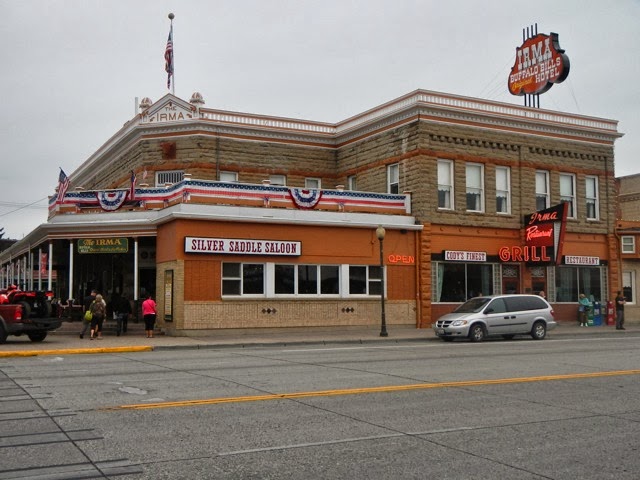The next morning is cloudy, but not raining, so we decide to try our luck again with Yellowstone Park, besides we come armed with a reservation at Fishing Bridge - the largest RV Campground in the park. Leaving Cody westward, the road follows the shore of Buffalo Bill Reservoir, part of the
Buffalo Bill State Park. This state park has good campgrounds and we considered staying at the North Fork, but opted to stay in town instead. The area is dotted with high end housing developments marked by expensive bronze statues at the front gate.
 |
| Looking west over Buffalo Bill Reservoir |
|
 |
| Nice statue of dueling Elk |
|
|
Close to the Buffalo Bill Dam, a tunnel takes us right through the mountain made up of pink and black granite as we move towards the Eastern Entrance of Yellowstone Park.
 |
| Tunnel through pink & black granite |
|
 |
| Approaching Yellowstone's Eastern Entrance |
|
|
On par for this trip, as we approach Yellowstone Park, it starts to rain again. Oh well, we'll just have to make the best of the rotten weather. So much for my fantasy of crystal clear blue skies in Yellowstone.
Yellowstone's geothermal features draw many visitors from all over the world to the park. In fact, the park contains over 10,000 thermal features with between 300 and 500 active geysers, which is more than 55% of the world's geysers.
What creates all of this geothermal activity? Basically most of Yellowstone Park sits in the
caldera of one of the world's greatest
supervolcanoes, which has and can blanket most of the United States with ash from a single eruption. Yellowstone's eruptions easily dwarf
Mt Saint Helen's 1980 massive explosion. If Yellowstone were to explode again, much of the life in the earth's northern hemisphere would disappear. Even if life survived the initial explosions and ash fall, the volcanic winters to follow would be difficult to survive. Let's just hope it doesn't blow during our lifetimes and especially while visiting the park.
 |
| Eastern Entrance |
|
 |
| Graphic of the Yellowstone's Caldera at the Norris Basin Museum |
|
 |
| Steam rising along Yellowstone River |
|
Even though it's a dreary day and we've been to many of Yellowstone's geothermal features before, I talk Peter into visiting some again as they fascinate me, besides I want to take photos - rain or no rain.
 |
| Mud Volcano |
|
 |
| Dragon's Mouth Spring |
|
 |
| Cooking Hillside |
|
 |
| Sulfur Caldron |
|
|
|
About the only wildlife we see in these areas are ravens.
 |
| Raven on railing by Mud Geyser |
|
 |
| Visitor walks like a Raven |
|
|
We follow the river up along the rim of the Grand Canyon of the Yellowstone to Artist Point. From the yellow sulfur in the canyon walls, even on a cloudy day it's easy to see how this area got the name of "Yellowstone."
 |
| Yellowstone Canyon |
|
 |
| Lower Falls |
|
 |
| Yellowstone Falls |
|
 |
| Painting a watercolor @ Artist Point |
|
The next stop is the Norris Geyser Basin. It's these types of landscapes that earned the fire and brimstone descriptions of the early explorers which were dismissed as "deliriums," until
official expeditions confirmed the other-worldly nature of Yellowstone befitting
Dante's Inferno.
 |
| Visitors at the entrance to the Norris Geyser Basin |
|
|
|
We start out on the Porcelain Basin part of the trails. With the colors reminding us of delicately painted porcelain plates, we agree it's aptly named.
 |
| Trail through Porcelain Basin |
|
|
|
We then take the Back Basin trail to see more of the basin. Although colors aren't as spectacular, there are some surprising pools.
 |
| Back Basin trail |
|
|
|
 |
| Norris Geyser Basin |
|
|
|
Once back up in the parking lot, it's hard not to notice all the tour buses and RVs parked there. In fact, we can't recall ever seeing this many tour buses on previous trips to Yellowstone - cars and RVs packed with families yes, but tour buses from Salt Lake City? This tour bus business seems to have grown up in the last 20 years to take mostly foreign visitors to our more spectacular parks
The rain isn't letting up any and seems to be settling in for a rainy evening as we drive back to Fishing Bridge.
By the time we get back, neither one of us is feeling much like cooking so we opt for checking out the Lake Lodge for dinner. It's a wonderful old traditional lodge and we enjoy an excellent fresh trout dinner.
After dinner we head back to the Fishing Bridge RV Park. It's probably the worst RV park we've ever stayed in, especially considering the price. It's basically just a large parking lot with hookups. Each space is so narrow you can hear conversations from your neighbors (one loud mouth keep talking until almost midnight despite being told we can hear every word). Not exactly the pristine wilderness experience we were looking for.
 |
| Close quarters at Fishing Bridge |
|
 |
| Still raining next morning |
|
 |
| Exiting Yellowstone Park via the South Entrance |
|













































































